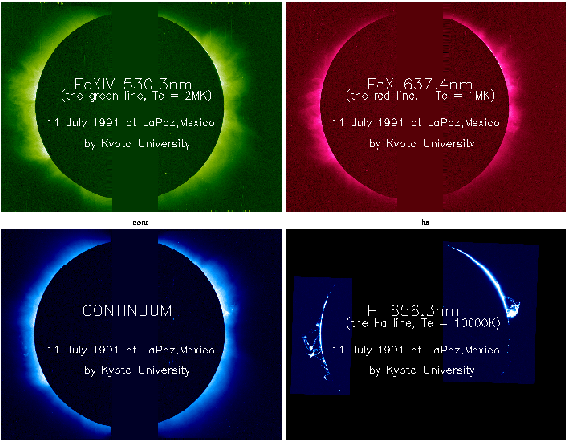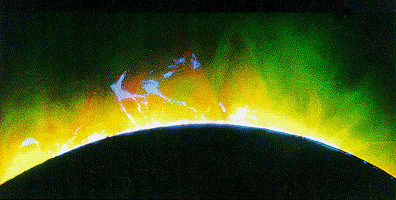The Corona in the Total Eclipse of the Sun
on July 11, 1991
on July 11, 1991

Click the image to see a high resolution image.
A very good solar eclipse for about 7 minutes was seen from Hawaii to Mexico on July 11,
1991.The expedition team from Kwasan and Hida Observatries of Kyoto University (H.Kurokawa, R. Kitai, K.Ishiura) went to La Paz
in Mexico and successfully obtained precious observational data.
These pictures were obtained in different emission lines and continuum, and show hetelogeneous
conronal structures in diffrent temperatures.
FeXIV 530.3nm (upper left, green).
The light in this wevelength is emitted by a 13 times
ionized iron ion formed at a temperature of about 2 million degrees. Since it is in a
green wavelength region, it is called as "Green Line".
FeX 637.4nm(upper right, red).
In this case the iron ion is ionized 9 times and so the
light is emitted from a lower temperature of about 1 million degrees. It is called as "Red Line".
Continuum(lower left, blue).
The image was obtained in the continuum of 610nm with
10nmwidth. The continuums intensity is preportinal to the total numbers of electrous along
the line of sight. The continuum image is closest to the corona we can see with the naked
eye at the total solar eclipse.
H-alpha (lower right, blue).
The H-alpha line(656.3nm) is emitted by hydrogen atoms and is formed at
a temperature of about 10,000 degrees. The so-called "Prominens" can be seen in this image.
3 color composite image

These images clealy show that the different coronal loops have diferent temperatures.
The scientific results from these data are found in Taketa,A. etc al.
(1999, Publ. Astron. Soc. Japan 52,375)
FeXIV 530.3nm (upper left, green). FeX 637.4nm(upper right, red). Continuum(lower left, blue). H-alpha (lower right, blue).
The light in this wevelength is emitted by a 13 times
ionized iron ion formed at a temperature of about 2 million degrees. Since it is in a
green wavelength region, it is called as "Green Line".
In this case the iron ion is ionized 9 times and so the
light is emitted from a lower temperature of about 1 million degrees. It is called as "Red Line".
The image was obtained in the continuum of 610nm with
10nmwidth. The continuums intensity is preportinal to the total numbers of electrous along
the line of sight. The continuum image is closest to the corona we can see with the naked
eye at the total solar eclipse.
The H-alpha line(656.3nm) is emitted by hydrogen atoms and is formed at
a temperature of about 10,000 degrees. The so-called "Prominens" can be seen in this image.
3 color composite image

These images clealy show that the different coronal loops have diferent temperatures.
The scientific results from these data are found in Taketa,A. etc al.
(1999, Publ. Astron. Soc. Japan 52,375)